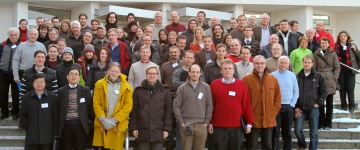Image of the week
|
|
Image: Hans-Joachim Christ, DESY
A delegation from the Japanese Society of Civil Engineering visited the European labs CERN and DESY this month to learn about how the laboratories run their projects.
|
In the News
-
from Nature
14 February 2012
Several basic-research programmes are trimmed, including nuclear physics and high-energy physics, a shift that is consistent with the administration’s emphasis on applied research that is most relevant to energy technology.
“Basic research is systematically down,” says Milind Diwan, a physicist at Brookhaven National Laboratory in Upton, New York, and co-spokesman for a planned particle physics experiment that received a drop in funding. “Those of us in fundamental-research have to live within those priorities.”
-
from BBC News
14 February 2012
The boost should improve the collider’s chances of discovering “new physics” and definitively confirming or denying the existence of Higgs boson particle.
The proton beams’ energies will be increased by 14%, for a total collision energy of 8 trillion electron volts.
-
from Science
13 February 2012
The news for high-energy physicists may be even worse. The budget for such research, which explores fundamental particles and forces primarily through particle collisions, would fall 1.8% to $777 million. That sounds like a mere haircut, but the effect at the United States’ last dedicated particle physics laboratory, Fermi National Accelerator Laboratory (Fermilab) in Batavia, Illinois, could be momentous. “At first blush, it looks like a fairly disastrous budget,” says Fermilab Director Pier Oddone.
-
from CERN
13 February 2012
It is accompanied by a strategy to optimise LHC running to deliver the maximum possible amount of data in 2012 before the LHC goes into a long shutdown to prepare for higher energy running. The data target for 2012 is 15 inverse femtobarns for ATLAS and CMS, three times higher than in 2011.
-
from IPMU
13 February 2012
Galaxies have no definite “edges”, the new research concludes. Instead galaxies have long outskirts of dark matter that extend to their nearby galaxies; the inter-galactic space is not empty but filled with dark matter
Copyright © 2025 ILC International Development Team




